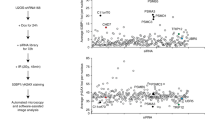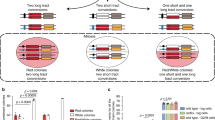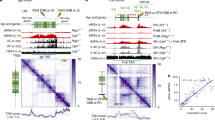Abstract
DNA double-strand breaks (DSBs) trigger ATM (ataxia telangiectasia mutated) signalling and elicit genomic rearrangements and chromosomal fragmentation if misrepaired or unrepaired. Although most DSB repair is ATM-independent, ∼15% of ionizing radiation (IR)-induced breaks persist in the absence of ATM-signalling1. 53BP1 (p53-binding protein 1) facilitates ATM-dependent DSB repair but is largely dispensable for ATM activation or checkpoint arrest. ATM promotes DSB repair within heterochromatin by phosphorylating KAP-1 (KRAB-associated protein 1, also known as TIF1β, TRIM28 or KRIP-1; ref. 2). Here, we show that the ATM signalling mediator proteins MDC1, RNF8, RNF168 and 53BP1 are also required for heterochromatic DSB repair. Although KAP-1 phosphorylation is critical for 53BP1-mediated repair, overall phosphorylated KAP-1 (pKAP-1) levels are only modestly affected by 53BP1 loss. pKAP-1 is transiently pan-nuclear but also forms foci overlapping with γH2AX in heterochromatin. Cells that do not form 53BP1 foci, including human RIDDLE (radiosensitivity, immunodeficiency, dysmorphic features and learning difficulties) syndrome cells, fail to form pKAP-1 foci. 53BP1 amplifies Mre11–NBS1 accumulation at late-repairing DSBs, concentrating active ATM and leading to robust, localized pKAP-1. We propose that ionizing-radiation induced foci (IRIF) spatially concentrate ATM activity to promote localized alterations in regions of chromatin otherwise inhibitory to repair.
This is a preview of subscription content, access via your institution
Access options
Subscribe to this journal
Receive 12 print issues and online access
$209.00 per year
only $17.42 per issue
Buy this article
- Purchase on Springer Link
- Instant access to full article PDF
Prices may be subject to local taxes which are calculated during checkout





Similar content being viewed by others
References
Riballo, E. et al. A pathway of double-strand break rejoining dependent upon ATM, Artemis, and proteins locating to γ-H2AX foci. Mol. Cell 16, 715–724 (2004).
Goodarzi, A. A. et al. ATM signaling facilitates repair of DNA double-strand breaks associated with heterochromatin. Mol. Cell 31, 167–177 (2008).
Ziv, Y. et al. Chromatin relaxation in response to DNA double-strand breaks is modulated by a novel ATM- and KAP-1 dependent pathway. Nature Cell Biol. 8, 870–876 (2006).
Kruhlak, M. J., Celeste, A. & Nussenzweig, A. Spatio-temporal dynamics of chromatin containing DNA breaks. Cell Cycle 5, 1910–1912 (2006).
Downs, J. A. et al. Binding of chromatin-modifying activities to phosphorylated histone H2A at DNA damage sites. Mol. Cell 16, 979–990 (2004).
Dimitrova, N., Chen, Y. C., Spector, D. L. & de Lange, T. 53BP1 promotes non-homologous end joining of telomeres by increasing chromatin mobility. Nature 456, 524–528 (2008).
Difilippantonio, S. et al. 53BP1 facilitates long-range DNA end-joining during V(D)J recombination. Nature 456, 529–533 (2008).
Lavin, M. F. Ataxia-telangiectasia: from a rare disorder to a paradigm for cell signalling and cancer. Nature Rev. Mol. Cell Biol. 9, 759–769 (2008).
Stewart, G. S. et al. The RIDDLE syndrome protein mediates a ubiquitin-dependent signaling cascade at sites of DNA damage. Cell 136, 420–434 (2009).
Doil, C. et al. RNF168 binds and amplifies ubiquitin conjugates on damaged chromosomes to allow accumulation of repair proteins. Cell 136, 435–446 (2009).
Kinner, A., Wu, W., Staudt, C. & Iliakis, G. γ-H2AX in recognition and signaling of DNA double-strand breaks in the context of chromatin. Nucleic Acids Res. 36, 5678–5694 (2008).
Stiff, T. et al. ATM and DNA-PK function redundantly to phosphorylate H2AX following exposure to ionizing radiation. Cancer Res. 64, 2390–2396 (2004).
Wilson, K. A. & Stern, D. F. NFBD1/MDC1, 53BP1 and BRCA1 have both redundant and unique roles in the ATM pathway. Cell Cycle 7, 3584–3594 (2008).
Stewart, G. S. et al. RIDDLE immunodeficiency syndrome is linked to defects in 53BP1-mediated DNA damage signaling. Proc. Natl Acad. Sci. USA 104, 16910–16915 (2007).
Maser, R. S., Monsen, K. J., Nelms, B. E. & Petrini, J. H. hMre11 and hRad50 nuclear foci are induced during the normal cellular response to DNA double-strand breaks. Mol. Cell. Biol. 17, 6087–6096 (1997).
Mirzoeva, O. K. & Petrini, J. H. DNA damage-dependent nuclear dynamics of the Mre11 complex. Mol. Cell Biol. 21, 281–288 (2001).
Melander, F. et al. Phosphorylation of SDT repeats in the MDC1 N. terminus triggers retention of NBS1 at the DNA damage-modified chromatin. J. Cell Biol. 181, 213–226 (2008).
Spycher, C. et al. Constitutive phosphorylation of MDC1 physically links the MRE11-RAD50-NBS1 complex to damaged chromatin. J. Cell Biol. 181, 227–240 (2008).
Chapman, J. R. & Jackson, S. P. Phospho-dependent interactions between NBS1 and MDC1 mediate chromatin retention of the MRN complex at sites of DNA damage. EMBO Rep. 9, 795–801 (2008).
Iwabuchi, K. et al. Potential role for 53BP1 in DNA end-joining repair through direct interaction with DNA. J. Biol. Chem. 278, 36487–36495 (2003).
Derbyshire, D. J. et al. Crystal structure of human 53BP1 BRCT domains bound to p53 tumour suppressor. EMBO J. 21, 3863–3872 (2002).
Manke, I. A., Lowery, D. M., Nguyen, A. & Yaffe, M. B. BRCT repeats as phosphopeptide-binding modules involved in protein targeting. Science 302, 636–639 (2003).
Yu, X., Chini, C. C., He, M., Mer, G. & Chen, J. The BRCT domain is a phospho-protein binding domain. Science 302, 639–642 (2003).
Lee, J. H., Goodarzi, A. A., Jeggo, P. A. & Paull, T. T. 53BP1 promotes ATM activity through direct interactions with the MRN complex. EMBO J. doi: 10.1038/emboj.2009.372 (2009).
Fernandez-Capetillo, O., Lee, A., Nussenzweig, M. & Nussenzweig, A. H2AX: the histone guardian of the genome. DNA Repair (Amst.) 3, 959–967 (2004).
Stucki, M. & Jackson, S. P. MDC1/NFBD1: a key regulator of the DNA damage response in higher eukaryotes. DNA Repair (Amst.) 3, 953–957 (2004).
Bekker-Jensen, S. et al. Spatial organization of the mammalian genome surveillance machinery in response to DNA strand breaks. J. Cell Biol. 173, 195–206 (2006).
Li, X. et al. Role for KAP1 serine 824 phosphorylation and sumoylation/desumoylation switch in regulating KAP1-mediated transcriptional repression. J. Biol. Chem. 282, 36177–36189 (2007).
Lee, Y. K., Thomas, S. N., Yang, A. J. & Ann., D. K. Doxorubicin down-regulates Kruppel-associated box domain-associated protein 1 sumoylation that relieves its transcription repression on p21WAF1/CIP1 in breast cancer MCF-7 cells. J. Biol. Chem. 282, 1595–1606 (2007).
Uziel, T. et al. Requirement of the MRN complex for ATM activation by DNA damage. EMBO J. 22, 5612–5621 (2003).
Lee, J. H. & Paull, T. T. Direct activation of the ATM protein kinase by the Mre11/Rad50/Nbs1 complex. Science 304, 93–96 (2004).
Riballo, E. et al. XLF-Cernunnos promotes DNA ligase IV-XRCC4 re-adenylation following ligation. Nucleic Acids Res. 37, 482–492 (2009).
Stiff, T. et al. ATR-dependent phosphorylation and activation of ATM in response to UV treatment or replication fork stalling. EMBO J. 25, 5775–5782 (2006).
Mailand, N. et al. RNF8 ubiquitylates histones at DNA double-strand breaks and promotes assembly 6of repair proteins. Cell 131, 887–900 (2007).
Iwabuchi, K., Bartel, P. L., Li, B., Marraccino, R. & Fields, S. Two cellular proteins that bind to wild-type but not mutant p53. Proc. Natl Acad. Sci. USA 91, 6098–6102 (1994).
Goodarzi, A. A. et al. Autophosphorylation of ataxia-telangiectasia mutated is regulated by protein phosphatase 2A. EMBO J. 23, 4451–4461 (2004).
Acknowledgements
We thank T. Paull for discussions of unpublished data, A. Vindigni for mass spectrometry analysis, K. Iwabuchi for 53BP1 expression constructs and Y. Shiloh and Y. Ziv for providing KAP-1 expression constructs. A.A.G. was supported by grants from the Alberta Heritage Foundation for Medical Research and the Association for International Cancer Research (AICR). The P.A.J. laboratory is funded by the MRC, AICR, the Wellcome Research Fund, the Department of Health (UK) and the EU integrated projects on DNA-Repair (LSHG-CT-2005-512113) and Risc-Rad (FI6R-CT-2003-508842).
Author information
Authors and Affiliations
Contributions
All authors contributed towards scientific discussion and manuscript editing. A.T.N. and A.A.G. performed the experiments. N.R. and M.L. provided PFGE data and, with A.S., first characterized the 53BP1/MDC1 DSB repair defect. G.S.S. provided RIDDLE syndrome cells complemented ± RNF168. A.A.G. and P.A.J. co-authored the manuscript and conceived and designed the study.
Corresponding authors
Ethics declarations
Competing interests
The authors declare no competing financial interests.
Supplementary information
Supplementary Information
Supplementary Information (PDF 3874 kb)
Rights and permissions
About this article
Cite this article
Noon, A., Shibata, A., Rief, N. et al. 53BP1-dependent robust localized KAP-1 phosphorylation is essential for heterochromatic DNA double-strand break repair. Nat Cell Biol 12, 177–184 (2010). https://doi.org/10.1038/ncb2017
Received:
Accepted:
Published:
Issue Date:
DOI: https://doi.org/10.1038/ncb2017
This article is cited by
-
HJURP is recruited to double-strand break sites and facilitates DNA repair by promoting chromatin reorganization
Oncogene (2024)
-
Transmembrane nuclease NUMEN/ENDOD1 regulates DNA repair pathway choice at the nuclear periphery
Nature Cell Biology (2023)
-
Satellite repeat transcripts modulate heterochromatin condensates and safeguard chromosome stability in mouse embryonic stem cells
Nature Communications (2022)
-
Radiation-induced DNA damage and repair effects on 3D genome organization
Nature Communications (2020)
-
Spatiotemporal dynamics of 53BP1 dimer recruitment to a DNA double strand break
Nature Communications (2020)



